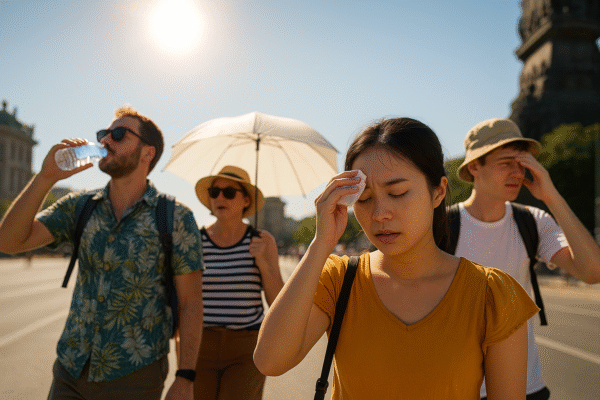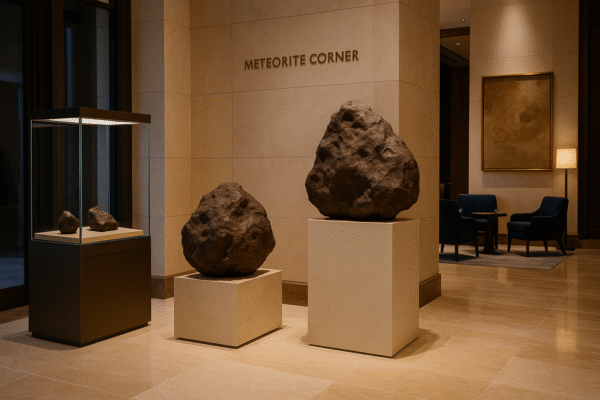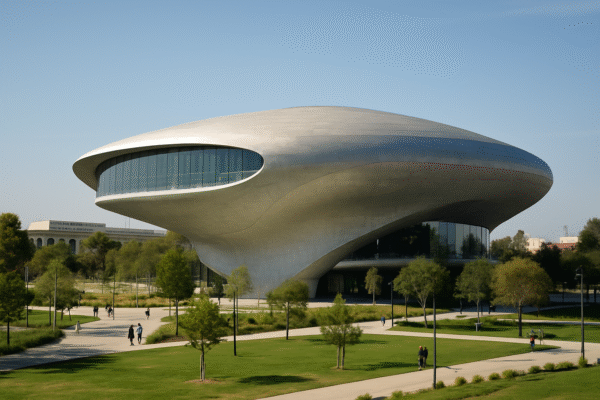Muscat, Oman – In a strategic move that elevates Oman’s status as a culturally rich and scientifically compelling destination, the Ministry of Heritage and Tourism (MHT) has unveiled the Meteorite Corner—an awe-inspiring exhibition of extraterrestrial treasures housed at the Mandarin Oriental Muscat. Seamlessly blending luxury hospitality with science and education, the Meteorite Corner introduces travelers to the celestial origins of our solar system while promoting Oman’s unique geological heritage.
Situated in the upscale Shatti Al-Qurum district, the Mandarin Oriental Muscat offers an opulent setting for this distinctive showcase. The exhibition forms part of Oman’s growing push to diversify its tourism offerings beyond nature and history—positioning the Sultanate as a leading destination for science-based cultural tourism in the Middle East.
A Luxury Venue for a Cosmic Display
The Meteorite Corner is the result of a visionary collaboration between the Omani government and the private sector. This partnership is designed to captivate both domestic and international visitors by offering access to a world-class collection of meteorites, primarily sourced from Oman’s famed Jeddat al-Harasis meteorite field.
The hotel lobby display features curated specimens that have significantly contributed to global scientific research. Visitors are treated to an interactive learning experience with multimedia exhibits explaining meteorite formation, cosmic impacts, and Oman’s pivotal role in preserving these ancient fragments of space.
Jeddat al-Harasis: A Global Scientific Treasure
Located in central Oman, the Jeddat al-Harasis desert is internationally renowned as one of the world’s most prolific meteorite hotspots. Over 1,300 meteorite fragments have been recovered across this barren stretch, offering scientists rare insights into planetary formation, asteroid belt dynamics, and the solar system’s earliest chapters.
Two extraordinary specimens featured in the Meteorite Corner exhibit exemplify Oman’s cosmic significance:
- Jeddat al-Harasis 91: Weighing an astonishing 4,600 kilograms, this meteorite represents the largest fall ever recorded in Oman. Discovered across a 52-kilometer trajectory, its fragments—over 700 in total—date back more than 12,600 years.
- Jeddat al-Harasis 73: A stony chondrite classified as L6, this meteorite once originated from the asteroid belt and fell approximately 15,600 years ago. Weighing over 20 tons, it shattered into 3,638 fragments along a 25.8-kilometer path.
These space rocks serve as invaluable tools in unraveling the mysteries of solar system formation, and their presence at a luxury hotel opens new doors for educational tourism in Oman.
Science Meets Tourism: Education at the Forefront
The Meteorite Corner is more than a museum—it’s an educational platform that immerses visitors in Oman’s ancient and cosmic narratives. Informational panels and interactive digital displays explain:
- The formation and classification of meteorites
- Their scientific significance in studying the solar system
- The legal framework governing their protection in Oman
In recent years, the Sultanate has implemented stringent policies to preserve meteorites under its Heritage and Antiquities Law, reflecting its commitment to scientific stewardship and cultural preservation. According to MHT, meteorites are national assets, protected from illegal trade and studied in collaboration with local and international research institutions.
Expanding Oman’s Tourism Horizons
By launching the Meteorite Corner, Oman is furthering its 2040 Tourism Strategy, which emphasizes sustainable tourism, cultural integration, and value-added experiences for global travelers. The initiative supports Oman’s vision to become a hub for educational, experiential, and heritage-driven tourism in the Gulf region.
The collaboration with Mandarin Oriental, one of the world’s most prestigious hospitality brands, enhances the appeal of the exhibit by situating it in an environment of refined elegance and international reach. Guests can experience both comfort and curiosity—unwinding in five-star accommodations while gazing upon meteorites that date back billions of years.
“This exhibit reaffirms Oman’s dedication to sharing its rich geological and natural history,” said an MHT spokesperson. “It creates a compelling reason for travelers to discover a side of Oman that many have yet to explore.”
Looking to the Future: New Partnerships and Experiences
The success of the Meteorite Corner is expected to inspire similar science-tourism collaborations across the Sultanate. Plans are underway to host astronomy workshops, meteorite discovery tours in central Oman, and public lectures led by planetary scientists.
These initiatives not only promote cultural awareness but also offer economic opportunities for local communities in remote regions like Jeddat al-Harasis, by integrating them into geotourism and conservation programs.
Conclusion: A Destination Written in the Stars
The Meteorite Corner at Mandarin Oriental Muscat exemplifies how Oman is redefining luxury travel through the lens of science, education, and culture. By celebrating its cosmic treasures in a refined setting, the Sultanate offers a one-of-a-kind experience that fuses intellectual curiosity with unforgettable hospitality.
Whether you’re an amateur stargazer, a passionate geologist, or a curious traveler seeking an offbeat luxury experience, Oman’s Meteorite Corner is your celestial gateway to discovery—one that starts in Muscat but stretches far beyond the stars.
For more travel news like this, keep reading Global Travel Wire





















